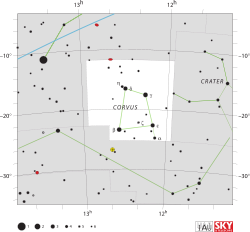Alchiba
| Alchiba (α) | |
 | |
| Observationsdata Epok: J2000.0 | |
|---|---|
| Stjärnbild | Korpen |
| Rektascension | 12t 08m 24,81652s[1] |
| Deklination | -24° 43′ 43,9504″[1] |
| Skenbar magnitud () | +4,03[2] |
| Stjärntyp | |
| Spektraltyp | F1 V[3] |
| U–B | +0,00[2] |
| B–V | +0,34[2] |
| Variabeltyp | Pulserande variabel av Gamma Doradus-typ (GDOR)?[4] |
| Astrometri | |
| Radialhastighet () | +3,0[5] km/s |
| Egenrörelse (µ) | RA: +99,52[1] mas/år Dek.: -39,19[1] mas/år |
| Parallax () | 66,95 ± 0,15[1] |
| Avstånd | 48,7 ± 0,1 lå (14,94 ± 0,03 pc) |
| Absolut magnitud () | 3,25[6] |
| Detaljer | |
| Massa | 1,39[4] M☉ |
| Radie | 1,46[7] R☉ |
| Luminositet | 4,91[8] L☉ |
| Temperatur | 7 041 ± 53[9] K |
| Metallicitet | -0,19 ± 0,04[9] dex |
| Vinkelhastighet | 16,9 ± 1,5[10] km/s |
| Andra beteckningar | |
| Alchiba, Al Minliar al Ghurab, Al Chiba, 1 Corvi, CD-24° 10174, GCTP 2796,00, GJ 455,3, HD 105452, HIP 59199, HR 4623, SAO 180505. [11] | |
Alchiba eller Alfa Corvi (α Corvi, förkortat Alfa Crv, α Crv) som är stjärnans Bayerbeteckning, är en ensam stjärna[12] belägen i den sydvästra delen av stjärnbilden Korpen. Den har en skenbar magnitud på 4,03[2] och är synlig för blotta ögat där ljusföroreningar ej förekommer. Baserat på parallaxmätning inom Hipparcosuppdraget på ca 67,0[1] mas, beräknas den befinna sig på ett avstånd på ca 49 ljusår (ca 12 parsek) från solen.
Nomenklatur[redigera | redigera wikitext]
Alfa Corvi har de traditionella namnen Al Chiba (arabiska ألخبا al-xibā, "tält") och Al Minliar al Ghurab (arabiska al-manxar al-ghurab)[13] eller Minkar al Ghurab. Det senare fanns i stjärnkatalogen i kalendern Al Achsasi al Mouakket, och översattes till latin som Rostrum Corvi (kråka).[14] År 2016 organiserade Internationella astronomiska unionen en arbetsgrupp för stjärnnamn (WGSN)[15] med uppgift att katalogisera och standardisera riktiga namn för stjärnor. WGSN fastställde namnet Alchiba för denna stjärna den 12 september 2016, vilket nu ingår i IAU:s Catalog of Star Names.[12]
Egenskaper[redigera | redigera wikitext]
Primärstjärnan Alfa Corvi är en gul till vit stjärna i huvudserien av spektralklass F1 V[3]. Den har en massa som är ca 40 procent[4] större än solens massa, en radie som är ca 1,5[7] gånger större än solens och utsänder från dess fotosfär ca 4,9[8] gånger mera energi än solen vid en effektiv temperatur på ca 7 000[9] K.
Alfa Corvi uppvisar periodiska förändringar i sitt spektrum över en tredygnsperiod, vilket tyder på att det antingen är en spektroskopisk dubbelstjärna eller (mer sannolikt) en pulserande Gamma Doradus-variabel.[4]
Källor[redigera | redigera wikitext]
- Den här artikeln är helt eller delvis baserad på material från engelskspråkiga Wikipedia, tidigare version.
Referenser[redigera | redigera wikitext]
- ^ [a b c d e f] van Leeuwen, F. (November 2007), "Validation of the new Hipparcos reduction", Astronomy and Astrophysics, 474 (2): 653–664, arXiv:0708.1752 , Bibcode:2007A&A...474..653V, doi:10.1051/0004-6361:20078357
- ^ [a b c d] Mermilliod, J.-C. (1986), "Compilation of Eggen's UBV data, transformed to UBV (unpublished)", Catalogue of Eggen's UBV data, SIMBAD, Bibcode:1986EgUBV........0M.
- ^ [a b] Gray, R. O.; et al. (July 2006), "Contributions to the Nearby Stars (NStars) Project: spectroscopy of stars earlier than M0 within 40 pc-The Southern Sample", The Astronomical Journal, 132 (1): 161–170, arXiv:astro-ph/0603770 , Bibcode:2006AJ....132..161G, doi:10.1086/504637.
- ^ [a b c d] Fuhrmann, K.; Chini, R. (2012). "Multiplicity among F-type Stars". The Astrophysical Journal Supplement. 203 (2): 20. Bibcode:2012ApJS..203...30F. doi:10.1088/0067-0049/203/2/30. 30.
- ^ Nordström, B.; et al. (2004), "The Geneva-Copenhagen survey of the Solar neighbourhood. Ages, metallicities, and kinematic properties of ~14000 F and G dwarfs", Publications of the Astronomical Society of Australia, 21 (2): 129–133, Bibcode:2004PASA...21..129N, doi:10.1071/AS04013.
- ^ ^ Elgarøy, Øystein; Engvold, Oddbjørn; Lund, Niels (March 1999), "The Wilson-Bappu effect of the MgII K line - dependence on stellar temperature, activity and metallicity", Astronomy and Astrophysics, 343: 222–228, Bibcode:1999A&A...343..222E.
- ^ [a b] https://www.universeguide.com/star/alchiba, hämtad 2018-04-21.
- ^ [a b] McDonald, I.; Zijlstra, A. A.; Boyer, M. L. (2012). "Fundamental Parameters and Infrared Excesses of Hipparcos Stars". Monthly Notices of the Royal Astronomical Society. 427 (1): 343–57. arXiv:1208.2037 . Bibcode:2012MNRAS.427..343M. doi:10.1111/j.1365-2966.2012.21873.x.
- ^ [a b c] Prugniel, P.; Vauglin, I.; Koleva, M. (2011). "The atmospheric parameters and spectral interpolator for the MILES stars". Astronomy & Astrophysics. 531: A165. arXiv:1104.4952 . Bibcode:2011A&A...531A.165P. doi:10.1051/0004-6361/201116769.
- ^ Ammler-von Eiff, M.; Reiners, A. (2012), "New measurements of rotation and differential rotation in A-F stars: are there two populations of differentially rotating stars?", Astronomy & Astrophysics, 542: 31, arXiv:1204.2459 , Bibcode:2012A&A...542A.116A, doi:10.1051/0004-6361/201118724, A116.
- ^ "* alf Crv". SIMBAD. Centre de données astronomiques de Strasbourg. Hämtad 2014-05-20.
- ^ [a b] "Naming Stars". IAU.org. Hämtad 16 december 2017.
- ^ Allen, Richard Hinckley, Star Names — Their Lore and Meaning: Corvus.
- ^ ^ Knobel, E. B. (June 1895), "Al Achsasi Al Mouakket, on a catalogue of stars in the Calendarium of Mohammad Al Achsasi Al Mouakket", Monthly Notices of the Royal Astronomical Society, 55: 429, Bibcode:1895MNRAS..55..429K, doi:10.1093/mnras/55.8.429.
- ^ IAU Working Group on Star Names (WGSN), International Astronomical Union, hämtad 22 maj 2016.
Externa länkar[redigera | redigera wikitext]
| |||||||||||||||||||





